Gold & Silver Boxes
Gold & Silver Boxes
Browse our collection of Small Antique Silver Boxes including Vinaigrettes, Novelty, Snuff and Tobacco Boxes, Nutmeg Graters
Vinaigrettes, popular from the late 18th century through the end of the 19th century, were small containers used for holding various aromatic substances, usually dissolved in vinegar. A tiny piece of sponge, soaked in the liquid, was contained beneath a grill or perforated cover. Ladies used to carry a vinaigrette with them to combat the aroma from the waste products common in cities. Likewise, the practice of wearing tight corsets also regularly caused a woman to faint, requiring the need to carry smelling salts.
Snuff boxes and Tobacco Boxes.
Tobacco. Tobacco was introduced into Europe circa 1580 however the first tobacco box, with the typical oval form and dome top pull off lid, did not appear until circa 1650. A smoker required a table to set out his “equipment” which included a long stemmed pipe and a pair of ember tongs.
Snuff. It is generally thought that snuff boxes, which were originally designed to be portable, had hinged lids to enable single handed use. The practice of grinding tobacco leaves to inhale the powder was first recorded in 1650 and it’s quick popularity created a demand for snuff boxes. The boxes were made in two sizes; personal boxes to fit in a waistcoat pocket which would hold a small quantity, enough for immediate consumption, and communal boxes made for table use. People of all social classes used these boxes when snuff was at its peak of popularity and the wealthy carried a variety of fancy snuff boxes in precious metals, with jewels, enamels and portrait miniatures. Boxes made for the poorer snuff takers were more ordinary; popular and cheap boxes were made in papier-mâché and even potato-pulp, which made durable boxes that kept the snuff in good condition. Even after snuff-taking ceased to be a general habit, the practice lingered among diplomats, doctors, lawyers and other professionals as well as members of professions where smoking was not possible, such as miners and print workers. Monarchs retained the habit of bestowing snuff-boxes upon ambassadors and other intermediaries as a form of honour.
Nutmeg Graters
Prior to the development of the nutmeg grater box in circa 1670, nutmeg was grated at the table using a steel grater. Early nutmeg graters were either heart shaped or teardrop form, of small size just large enough to contain a nutmeg. The box had two hinged lids, top and bottom, one side with the steel grater, the other containing the grated spice. Other early forms include the tubular variety with pull off lid and silver sleeve, and the rare silver mounted cowrie shell with strapwork mounted grater.
During the 18th century designs progressed to include both functional and very charming novelty and decorative varieties.
The use and manufacture of nutmeg graters was circa 1650-1865 (ref. Eric Delieb “Investing in Silver”) but the earliest fully marked boxes didn’t arrive before circa 1697. The nutmeg originated from the Indies and is mentioned in early literature as a fumigation against the plague.
Counter Boxes.
Not many of these small cylindrical boxes survive from earlier than 1650. They usually have a cap cover, some have pierced sides and even pierced ends. Many of these boxes still contain up to as many as 30 thin silver discs, often finely stamped with the portraits of the Kings and Queens of England. A rare form of these is the circular score box. There is an example in the Birmingham Assay Office by Samuel Pemberton date 1799, the top engraved with the numbers up to 10 and has a moveable pointer. It was probably intended for pool or whist.
-

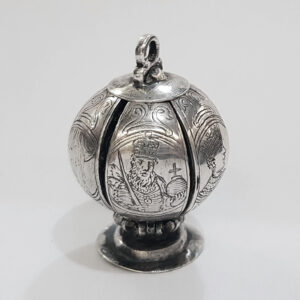
Circa 1600 - 1620
10349 17th Century Antique Silver Pomander
Sold
An intriguing piece of history contained in a small silver sphere. The antique silver pomander was worn round the neck or suspended from a belt and was intended to protect the wearer from sickness. The exterior of this example is hand engraved with royal portraits, probably English, based on engravings by Simon de Passe (c. 1595 – 6 May 1647). The screw top unturns to release six hollow, hinged segments to contain dried flowers, spices and scented oils. The interior is decorated with scroll and hatched engraving. A similar example formed part of the prestigious David Little collection. Weight 22 grams, less than 1 troy ounce. Height 3.9cm. Spread 5.6cm fully extended. Unmarked silver. Probably English. Circa 1600-20.
-

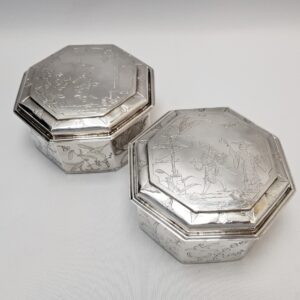
1680
Ralph Leake
10419 Pair of Charles II Antique Silver Boxes
An outstanding pair of 17th century silver toilet boxes of octagonal form with pull off lids. Good size and weight. The charming decoration is a superb example of the flat chased chinoiserie style popular in the late 1600’s. Each box depicts a different scene incorporating two Chinese figures within a backdrop of architectural ruins and exotic plants and birds. At this date boxes of this type would have originally been part of an extensive toilet service. Weight 738g, 23.7 troy oz. Width 13.7cm, 5.4 inches. Height 7.2cm, 2.8 inches. London 1680. Maker Ralph Leake. Sterling silver.
-

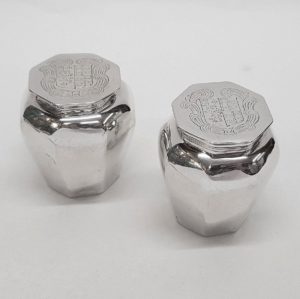
Circa 1690
Anthony Nelme
9371 17th Century Antique Silver Boxes
A pair of early English antique silver toilet jars with lift off lids. Plain octagonal form. The tops have a hand engraved armorial within plumage feathers, typical of the Charles II/James II period. These unusual miniature toilet jars are very charming. Superb antique colour. At this date boxes of this type would have originally been part of an extensive toilet service. Total weight 148 grams, 4.7 troy ounces. Height 6cm. Diameter of lid 3.8cm. Makers mark only for Anthony Nelme. Circa 1690. Sterling silver.
-

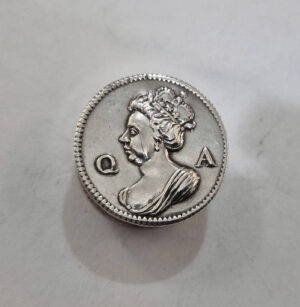
Circa 1710
Thomas Kedder
10454 Queen Anne Antique Silver Box
Sold
A charming little historical item. An early 18th century silver counter box of small size containing 11 embossed gaming counter/medalettes. The pull off cover is embossed with a portrait bust of Queen Anne between “Q and A”. Prick dot owner’s initials “EW” below. Weight 11g. Diameter 2.4cm, 0.95ins. Height 1.1cm, 0.4ins. Maker Thomas Kedder, a known box maker of the period. Circa 1710. Unmarked silver.
-

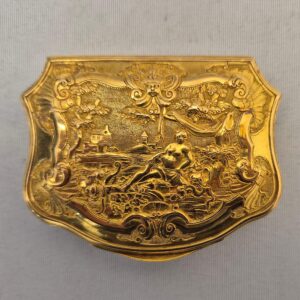
Circa 1720 - 1730
10437 George I Antique Gold Snuff Box
A sumptuous early 18th century gold box of cartouche form with a hinged lid. The top panel is chased with the classical goddess Diana reclining in a forest setting with an Apollo mask above. The shaped side panels are decorated with dogs and birds. There is an old German or Austrian collector’s label attached inside. Supplied with later fitted blue box.
Weight 68g, 2 troy oz approx. Width 6.5cm, 2.5ins. English, Dutch or German. Circa 1725. Solid gold, high grade probably 18 or 22ct. -

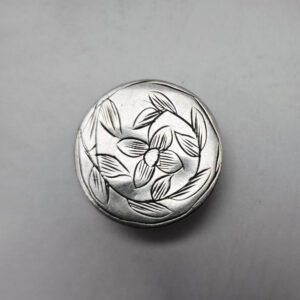
Circa 1720
William Paradise
10455 George II Antique Silver Box
A sweet little antique silver box with a pull off cover. Tiny size, possibly for pills or counters/tokens. The lid has a hand engraved flower and leaf design in the late 17th century style. Weight 3g. Diameter 1.9cm, 0.75ins. Height 0.9cm, 0.35ins. Maker possibly William Paradise. Circa 1720. Unmarked silver.
-


Circa 1725
10442 18th Century Antique Gold Box
An exquisite little antique gold patch box of circular form with excellent quality chased decoration. Very crisp. Lift off lid. Excellent colour. Weight 33g, 1 troy oz. Height 1.5cm, 0.59ins. Probably Augsburg, Germany. Circa 1725. Solid gold, probably 18 carat.
-

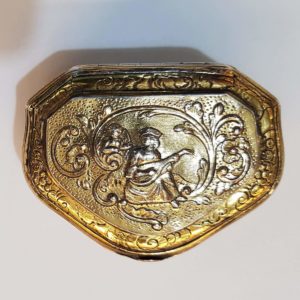
1740
9957 George II Antique Silver Cashew Box
An attractive little antique sterling silver cashew box, or silver snuff box, of heart shaped design. Original gilt finish. The embossed lid decoration shows a young man playing a lute with a putto in the background. Weight 40 grams, 1.2 troy ounces. Height 2.5cm. Top measures 6 x 5cm. London 1740. Maker “LM”. Sterling silver.
-

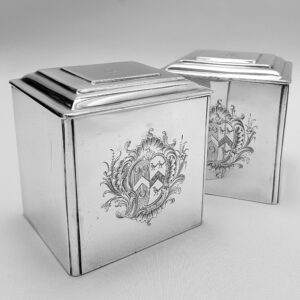
1746
John Swift
10388 George II Pair of Antique Silver Tea Caddies
Sold
An exceptional pair of rectangular silver tea cannisters with stepped hinged lids and canted corners. The plain form, almost cubic, is very attractive. To the front of each is an expansive hand engraved armorial for Martin within a decorative cartouche, the covers have a crest. Total weight 805g, 25.8 troy oz. Height 9.6cm. Width 9.2cm. Depth 8.4cm. London 1746. Maker John Swift. Sterling silver.
-

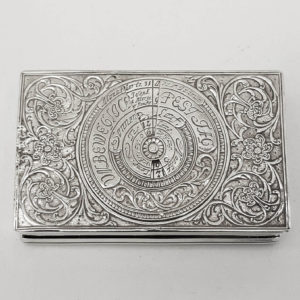
Circa 1750
9674 Antique Silver Perpetual Calendar Snuff Box
Sold
An 18th century silver snuff box with rotating dials to both sides. Very charming and retains the interior gilding. The panels have scrolled flower and chased decoration. The top side has the rotatable “Calendarium Perpetuum” which shows the days of the week (in old German script, and marked with their planetary signs) against days of the month. The reverse side has seven readout windows described by the headings on the rotatable disk (in old German script) – 1) month of the year with its number of days, 2) the important saints’ and feast days in the month, 3) sun’s Zodiacal position (represented by amusing little hand engraved zodiac symbols), 4) length of day, 5) length of night, 6) time of sun rise, and 7) time of sunset. A good example in very good condition. 126 grams, 4 troy ounces. Length 8.4cm. Width 5.5cm. Height 2cm. German. Probably 18th century circa 1750. Unmarked silver.
-

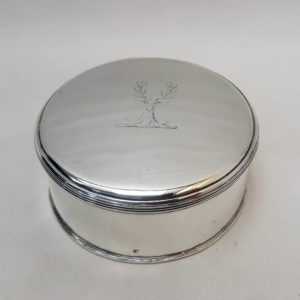
1769
William & Aaron Lestourgeon
10282 George III Antique Silver Box
An attractive antique silver toilet box of plain cylindrical form with pull off lid and reeded rims. The top is hand engraved with a stag crest. Useful size suitable as a jewellery box or for cuff links. Weight 231 grams, 7.4 troy ounces. Height 4.7cm. Diameter 10.1cm. London 1769. Maker William & Aaron Lestourgeon. Sterling silver. 18th century.
-

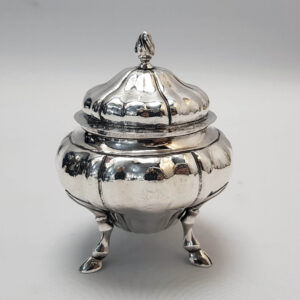
Circa 1780
Francesco Arnaud
10387 Maltese Antique Silver Sugar Bowl and Cover
An attractive 18th century antique silver sugar box of inverted pear form with a pull off dome cover. The fluted tapering body is raised on three cast hoof feet. Weight 180g, 5.7 troy oz. Height 12.2cm. Spread across the body 10cm. Malta circa 1780, Rohan Period (1775-97). Maker Francesco Arnaud.
-


Circa 1800
10443 French Antique Gold Aide Memoire
A very beautiful Palais Royal solid gold and real mother of pearl writing companion in the form of a book. Superbly engraved on both sides with sprays of flowers and fitted with a solid gold propelling pencil. By removing the pen, this fine piece opens to reveal a yellow silk interior with blank notepaper. Weight of pen 8g, 0.25 troy oz. Weight of book including pearl and interior 143g, 4.59 troy oz. Length 10.5cm, 4.1ins. Width 7.3cm, 2.8ins. France circa 1820. Pen and Book with French gold marks.
-

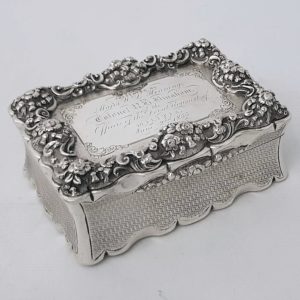
1854
Yapp & Woodward
9838 Antique Silver Table Snuff Box
A magnificent antique sterling silver box of military interest. Substantial size and weight. Original gilt interior. Crisp cast borders and engine turned decoration to the sides and base. The top bears a regimental inscription. This box is likely to have been used in the Officer’s Mess for the Loisel Regiment of Militia. Weight 572 grams, 18.3 troy ounces. Height 5.5cm. Top measures 12.5cm x 9.3cm. Birmingham 1854. Maker Yapp & Woodward. Sterling silver.
-

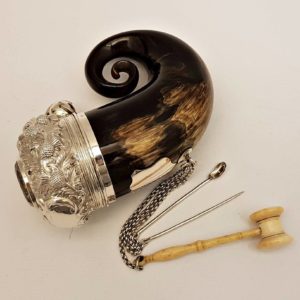
Circa 1860
9624 Antique Scottish Silver Snuff Mull
Sold
An antique horn snuff mull with a broad silver mount embossed with thistles. The hinged lid is inset with a large citrine gemstone. Spread 14.5 cm. Diameter 6.5 cm. Unmarked silver. Probably Scottish circa 1860.